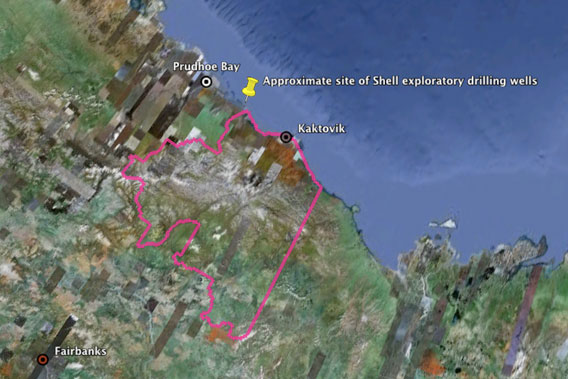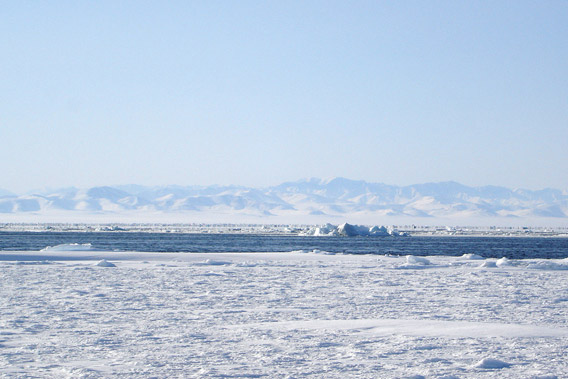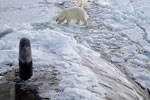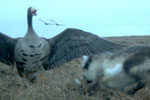
Approximate site of preliminarily approved drilling by Shell. Pink outline is the Arctic National Wildlife Refuge (ANWR). Image made with Google Earth.
Last week, the U.S. Department of the Interior approved oil spill clean-up plans by Royal Dutch Shell Oil in the Beaufort Sea, paving the way for offshore oil drilling in the Arctic to begin as soon this year. The Interior’s approval was blasted by environmentalists, who contend that oil companies have no viable way of dealing with a spill in the icy, hazardous conditions of the Arctic, far from large-scale infrastructure. Shell, which has spent $4 billion to date to gain access to the Arctic, must still be granted final permits for drilling.
“All signs point to environmental disaster if an oil spill were to occur in the harsh Arctic waters—it’s just absurd that Shell’s unproven response plan got the green light,” Miyoko Sakashita, oceans director with the Center for Biological Diversity, said in a press release.
Shell’s oil spill plan consists of a fleet of response vehicles to follow its two drilling rigs and a containment cap similar to that used on the Deepwater Water Horizon oil spill.
The decision to move forward on oil drilling in the Beaufort Sea, which would occur just north of the western edge of Arctic National Wildlife Refuge (ANWR), comes shortly after the Obama Administration also opened up drilling in the Arctic’s Chukchi Sea, allowing oil exploitation in the Arctic for the first time since the 1990s.
Spokesperson for Royal Dutch Shell, Kelly op de Weegh, dubbed the approval, “another major milestone achieved.”
“It further reinforces that Shell’s approach to Arctic exploration is aligned with the high standards the Department of Interior expects from an offshore leader and adds to our confidence that drilling will finally commence in the shallow waters off Alaska this summer.”
The oil spill plan approval comes on the heels of Obama Administration touting an “all of the above” energy strategy that is increasing the exploitation of fossil fuels, from offshore oil drilling to fracking, while at the same time providing some support for renewable industries.
But concerns linger about Shell’s drilling plans. For one thing, the Department of the Interior approved drilling in the Beaufort Sea through October 31st, which allows drilling up to the onset of seasonal ice. If a spill occurred in October, experts fear the oil company would not have time to clean-up as ice closed in. In fact, these fears, lead the Department of the Interior to maintain that Shell stop drilling in the nearby Chukchi Sea 38 days before seasonal ice would arrive; however the Department of the Interior put no such regulations on drilling in the Beaufort Sea. Shell is currently pushing for the government to drop its end date in the Chukchi Sea as well.
But environmentalists say the company is Pollyannaish regarding the extreme conditions of the Arctic.
“The Arctic Ocean is prone to hurricane-force storms, 20-foot swells, sea ice up to 25 feet thick, sub-zero temperatures and months-long darkness. What’s more, the Arctic has extremely limited infrastructure (there are no roads or deep water ports and only a handful of small airports) and the nearest Coast Guard station is 1,000 miles away,” says Cindy Shogan, Executive Director of the Alaska Wilderness League.
Echoing doubts raised by environmentalists, a recent report by the U.S. Government Accountability Office highlighted a number of risks still posed by Shell’s drilling plans even with its oil spill plan.
“There are few additional resources available in the region to respond in the event that Shell’s capabilities are insufficient,” the report warns, noting that Shell’s plans “do not completely mitigate some of the environmental and logistical risks associated with the remoteness and environment of the region.”
The Beaufort Sea is home to bowhead and beluga whales, seals, walruses, polar bears, and a wide variety of migrating birds. In addition, indigenous communities depend on the sea for their livelihoods.
Legal action by Shell against protestors
In response to rising criticism by environmental groups, Shell has recently filed a lawsuit against eleven indigenous and environmental organizations that have challenged Arctic offshore drilling.
Another lawsuit targeted activist-group Greenpeace specifically. This week Shell won a preliminary injunction ordering Greenpeace volunteers and activists to keep one kilometer away from Shell’s main drilling ships until after the drilling season would end.
Greenpeace made headlines last year for targeting Cairn Energy’s exploratory drilling in the Arctic off of Greenland. Nonviolent protests included boarding Cairn’s oil rigs and halting drilling for a number of days. Even the head of Greenpeace was involved: Kumi Naidoo was arrested after scaling Cairn’s drilling rig to demand the company release its oil spill plans.
“For me and for many people around the world this is now one of the defining environmental struggles of our time,” Naidoo said on a video before scaling the rig. “It’s a fight for sanity against the madness that sees the disappearance of the Arctic ice not as a warning, but as an opportunity to seek further profits.”
The Arctic drilling debate often focuses on the direct impact of oil spills, and not the long-lasting perils of climate change. Yet, the Arctic has seen the biggest impacts from climate change to date with sea ice vanishing and temperatures rising faster there than anywhere else on Earth. Scientists have long warned that the world needs to quickly move away from fossil fuels in order to mitigate global climate change, but governments with stakes in the Arctic have yet to heed these calls: instead they have viewed less seasonal ice due climate change as a chance to exploit the region for more fossil fuels.

Arctic Ice Pack, Beaufort Sea. Photo by: Bigstock.
Related articles
Arctic warms to highest level yet as researchers fear tipping points

(02/13/2012) Last year the Arctic, which is warming faster than anywhere else on Earth due to global climate change, experienced its warmest twelve months yet. According to recent data by NASA, average Arctic temperatures in 2011 were 2.28 degrees Celsius (4.1 degrees Fahrenheit) above those recorded from 1951-1980. As the Arctic warms, imperiling its biodiversity and indigenous people, researchers are increasingly concerned that the region will hit climatic tipping points that could severely impact the rest of the world. A recent commentary in Nature Climate Change highlighted a number of tipping points that keep scientists awake at night.
Opposition rising against U.S. Arctic drilling
(02/09/2012) Drilling in the Arctic waters of the U.S. may become as contested an issue as the Keystone Pipeline XL in up-coming months. Scientists, congress members, and ordinary Americans have all come out in large numbers against the Obama Administration’s leases for exploratory drilling in the Beaufort Sea and the Chuckchi Sea.
Photos: camera traps reveal oil’s unexpected impact on Arctic birds

(10/26/2011) A study in the Alaskan Arctic, employing camera traps, has shown that oil drilling impacts migrating birds in an unexpected way. The study found that populations of opportunistic predators, which prey on bird eggs or fledglings, may increase in oil drilling areas, putting extra pressure on nesting birds. Predators like fox, ravens, and gulls take advantage of industry infrastructure for nests and dens, moving into areas that may otherwise be inhospitable. In addition, garbage provides sustenance for larger populations of the opportunists.
Obama administration opens more of the Arctic to drilling
(10/05/2011) Nearly 500 Arctic oil and gas leases from the Bush administration have been restarted this week by the Obama administration. Known as Chukchi Lease 193, the various leases had been held up in court after environmental groups and indigenous groups challenged them, citing a significant lack of baseline information about the Chukchi Sea ecosystem. The Obama administration now says that many of the ecosystem gaps need not be filled, but Arctic indigenous and environmental groups disagree.
Deepwater spill ‘meets the Titanic’: groups sue to stop Arctic drilling
(09/29/2011) Following the Obama administration’s approval of Royal Dutch Shell to drill in the Arctic’s Beaufort Sea, a wide-swathe of environmental have filed a lawsuit to stop the drilling, which could begin as early as next summer. Those filing the lawsuit today blasted Shell for what they perceived as a pathetic oil spill response plan, and the Obama administration for acquiescing to the big oil company.
Climate change shocker: Canada’s ice shelves halved in six years
(09/28/2011) After the Arctic sea ice extent hit its second lowest size on record this summer—or lowest (depending on the source)—comes another climate change shocker: in the past six years Canada’s millennia-old ice shelves have shed nearly half their size. One ice shelf—the Serson shelf—is almost entirely gone, while another—the Ward Hunt shelf—has split into two distinct shelves. The ice shelves have lost 3 billion tons in this year alone.
Northwest Passage open as sea ice falls to lowest cover ever recorded
(09/12/2011) Arctic sea ice cover fell to its lowest level on record, report researchers from the University of Bremen.
Mass walrus haul-outs, polar bear cub mortality linked to climate change

(09/01/2011) Recent, unprecedented walrus haul-outs and increased instances of long-distance swims by polar bears show the direct impacts on wildlife of dwindling Arctic sea ice from climate change. These threatened species also face the prospect of offshore drilling in the Arctic after the Obama Administration recently approved a number of plans to move forward on oil exploration. At least 8,000 walruses hauled out on an Alaskan beach along the Chukchi Sea on August 17. Only a day before, the U.S. Geological Survey announced it would begin tagging walruses near Point Lay, Alaska to study how a lack of sea ice is affecting the species.